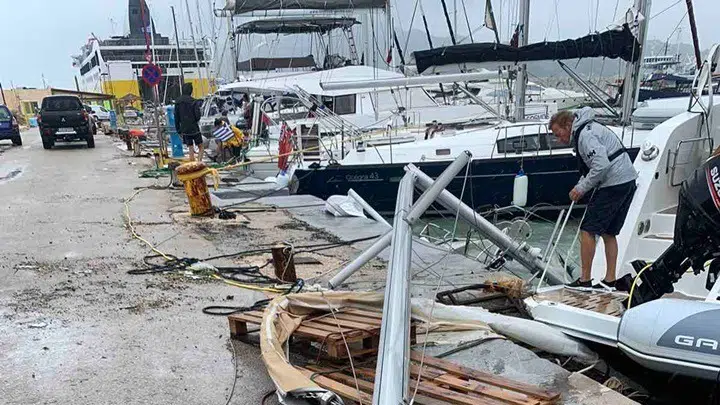
Following August’s catastrophic fires in Greece, scientists are warning of floods in the affected areas that could bring more devastation if a “medicane” hits.
A medicane is a tropical-like cyclone originating in the Mediterranean. The weather phenomenon devasted parts of Greece in September 2020. After receiving various names from different meteorological centers, the storm, dubbed Ianos by the METEO unit of the National Observatory of Athens, rapidly intensified while moving northeastward.
After hitting Italy, the storm went on to strike Malta and Crete with tropical storm-force winds. Despite land interaction, the small cyclone reached its peak intensity of 120 km/h (75 mph) on September 18, immediately before making landfall in southwestern Greece. After landfall, Ianos turned back out to sea and moved south-southeastward, before dissipating on September 21.
Damage was severe in Greece, with cities in the central part of the country getting the brunt of the storm’s impacts. Cities such as Karditsa and Mouzaki were flooded for several days. Heavy agricultural damage was reported in rural areas north of Athens. A state of emergency was declared for the islands of Ithaca, Kefalonia, and Zakynthos.
Four people were killed. Ianos caused at least $100 million (2020 USD) in damages.
Global warming and medicanes
Studies have evaluated that global warming can result in higher observed intensities of tropical cyclones as a result of deviations in the surface energy flux and atmospheric composition, which both heavily influence the development of medicanes as well.
In tropical and subtropical areas, sea surface temperatures (SSTs) rose 0.2 °C (0.36 °F) within a 50-year period, and in the North Atlantic and Northwestern Pacific tropical cyclone basins, the potential destructiveness and energy of storms nearly doubled within that same time, evidencing a clear correlation between global warming and tropical cyclone intensities.
Within a similarly recent 20-year period, SSTs in the Mediterranean Sea increased by 0.6 to 1 °C (1.1 to 1.8 °F).
A recent study by the Italian branch of the World Wildlife Foundation found that with temperatures rising 20 percent faster than the global average and sea levels also rising — they are projected to have risen one meter by 2100 — the Mediterranean is becoming the saltiest and fastest-warming sea on the planet.
“Urgent action is needed to further mitigate greenhouse gas emissions and adapt to the new reality of a warming sea,” the WWF said.
Although scientists have not as yet established a clear link between fires and medicanes, they say that devasting floods could follow the fires.
Increased risk of floods in Greece
Niki Evelpidou, a professor of geomorphology and geographical information systems at the National and Kapodistrian University of Athens, has warned of flood risk in the fire-affected areas as they are still assessing the damage caused by the wildfires.
Recalling August of 2020 when flash floods hit Evia island and eight people lost their lives in areas which had suffered fires just a few months earlier, Evelpidou said she and her colleagues have already identified a few of the high-risk flood zones in areas burnt by this summer’s fires.
“We must shield ourselves against the next catastrophe. We cannot respond immediately in all areas, but we can see which streams will be linked to floods that will pass through residential areas,” she told Xinhua news agency.
Greek scientist Efthymios Lekkas, a Professor of Dynamic Tectonic Applied Geology and Disaster Management at the National and Kapodistrian University of Athens, warned of the environmental destruction caused by the fires, and stressed the increased risk of floods in Greece in the wake of the blazes that have plagued the country.
Lekkas said that the geomorphology of the areas in the Peloponnese and on Evia that are now burned will ”change drastically.”
As he explained, the complex web of root systems is integral to maintaining the structure of the landscape. Roots embedded deep in the ground help to keep the soil in place, stabilizing it during any potential rainfall, no matter how torrential.
Additionally, healthy forest ecosystems protect the ground against the physical impact of the heavy rainfall, and therefore prevent flooding to a degree.
As forests are stratified into four layers — the upper canopy, the middle level, the underbrush level, and the forest floor — heavy rains are filtered through at the higher levels, and the soil on the forest floor is protected from the brunt of heavy rainfall.
When these roots are burned and destroyed, the soil is not kept in place, and any rainfall received could destabilize the ground, resulting in mud and landslides.
See all the latest news from Greece and the world at Greekreporter.com. Contact our newsroom to report an update or send your story, photos and videos. Follow GR on Google News and subscribe here to our daily email!



